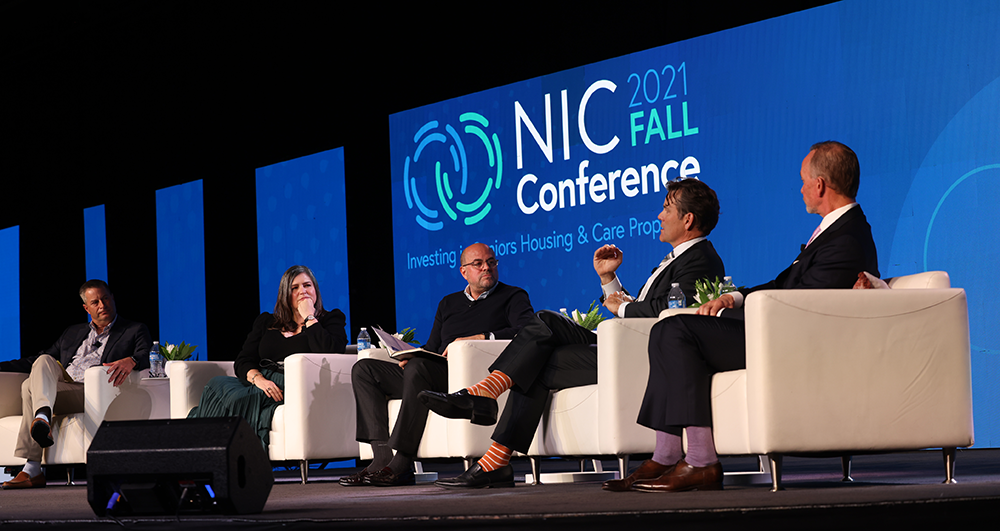Senior Living investors and operators discuss innovative approaches.
The pandemic has been a stress test like no other for owners, operators, and lenders alike. Lessons have been learned. But what’s the best way to align incentives among the stakeholders for success going forward?
A panel discussion at the 2021 NIC Fall Conference explored the possibilities. The session, “Capital for Operations: Aligning Incentives,” was moderated by Torey Riso, managing director at Huron Consulting. He was joined on the panel by Brian Beckwith, CEO, Arcus Healthcare Partners; Mercedes Kerr, president, Belmont Village Senior Living; Fee Stubblefield, CEO & founder, The Springs Living; and Chris Taylor, managing director, Capital One Healthcare.
Considering the events of the last 20 months, Riso asked: “What kinds of incentive structures between operators and capital sources are now most sustainable to produce returns and best serve the interests of the resident populations?”
The panelists agreed that capital providers have been patient during the pandemic. “Lenders stepped up,” said Beckwith. They adjusted agreements as needed to keep operators afloat as they struggled with occupancy, cashflow, and labor issues.
Stubblefield echoed that sentiment. “We could not have gotten through this without our financial partners,” he said. “This was tough.”
Kerr noted that capital partners have been patient because the fundamentals of the business represent a great opportunity amid the growing demographic wave of older adults. Capital One’s Taylor said, “We’re in this for the long term.” He added that as a lender he wants to align with the right owners and operators.
Even so, the panelists acknowledged several issues currently confronting the industry, especially the rise in expenses and the shortage of labor. “The industry needs a coordinated effort around labor,” said Beckwith.

Management Fees in Flux
Riso asked if the standard 5% management fee is still the right number.
“The 5% fee is broken,” said Taylor. He explained that investors and operators are coming up with creative alternatives to provide care.
Beckwith said there are cases where the 5% formula might work if a particular facility is in an attractive location and does not need a lot of resources. But investors understand that the quality of the services provided is directly correlated to financial performance. Negotiating which party spends what amount on which resources means that the investor has to understand the operator and what they need to make the facility successful, according to Beckwith.
Stubblefield’s company doesn’t take fee managed assignments. Instead, the company co-invests with its capital providers or owns the properties outright. “We have to be vertically integrated all the way to build incentives,” he said.
Riso asked whether senior living projects can be valued like a cash flow business rather than as real estate.
“Investors in this space recognize this is operationally intensive,” said Kerr. She noted the importance of investing in operations. For example, the pandemic has resulted in innovations such as telemedicine which is improving efficiencies.
Stubblefield sees the pandemic as a “great pivot point.” Owners and operators have had to align their interests to reach the best long-term result for the community. But he added, “We have to make our case to capital providers. We have to point out what we need.”
Beckwith noted that the separation of the real estate from operations has provided an efficient source of capital that has been great for the industry. “It’s a challenge to make sure the operations side and real estate mesh,” he said.
The panelists foresee a lot of experimentation with capital structures to align operational and investment interests.
“There doesn’t have to be one answer,” said Kerr. Some structures provide an opportunity for the operator to share in the upside based on performance benchmarks. But those arrangements don’t work when faced with an unexpected event like a pandemic.
Kerr thinks senior living performance standards could evolve in a way similar to that of the hotel industry where an operator’s results are judged against the performance of its peers. “More data transparency and benchmarking might be an answer to the question of how to hold an operator accountable,” she said.
Beyond financial performance, there are other ways to create alignment among partners by sharing cultural or aspirational objectives, noted Kerr. “Parties driving toward a goal together is a great motivator,” she said.
Beckwith said that the industry is trying to figure out what works best. Compressed margins are impacting valuations, making it a balancing act to generate returns while allowing the operator to make the right decisions.
Capital providers can see the value of investing in operations to deliver the best product. But, Stubblefield observed: “Operators have to lead the way.”
About NIC
The National Investment Center for Seniors Housing & Care (NIC) is a nonprofit 501(c)(3) organization whose mission is to support access and choice for America’s seniors by providing data, analytics, and connections that bring together investors and providers.
Connect with NIC
Read More by NIC